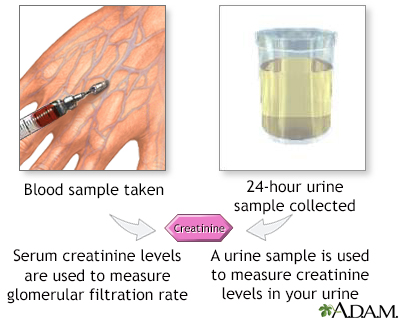Pregnancy SmartSiteTM
Serum creatinine; Kidney function - creatinine; Renal function - creatinine DefinitionThe creatinine blood test measures the level of creatinine in the blood. This test is done to see how well your kidneys are working. Creatinine in the urine can be measured with a urine test. How the Test is PerformedHow to Prepare for the TestYour health care provider may tell you to temporarily stop taking certain medicines that can affect the test. These medicines include:
Tell your provider about all the medicines you take. How the Test will FeelWhen the needle is inserted to draw blood, some people feel moderate pain. Others feel only a prick or stinging sensation. Afterward, there may be some throbbing or slight bruising. This soon goes away. Why the Test is PerformedCreatinine is a chemical waste product of creatine. Creatine is a chemical made by the body and is used to supply energy mainly to muscles. This test is done to see how well your kidneys work. Creatinine is removed from the body entirely by the kidneys. If kidney function is not normal, the creatinine level in your blood will increase. This is because less creatinine is excreted through your urine. Normal ResultsA normal result is 0.7 to 1.3 mg/dL (61.9 to 114.9 µmol/L) for men and 0.6 to 1.1 mg/dL (53 to 97.2 µmol/L) for women. Women often have a lower blood creatinine level than men. This is because women often have less muscle mass than men. Creatinine level varies based on a person's size and muscle mass. The examples above are common measurements for results of these tests. Normal value ranges may vary slightly among different laboratories. Some labs use different measurements or test different samples. Talk to your provider about the meaning of your specific test results. What Abnormal Results MeanA higher than normal creatinine level may be due to:
A lower than normal creatinine level may be due to:
There are many other conditions for which the test may be ordered, such as high blood pressure, diabetes, or medicine overdose. Your provider will tell you more if needed. RisksThere is little risk involved with having your blood taken. Veins and arteries vary in size from one person to another and from one side of the body to the other. Taking blood from some people may be more difficult than from others. Other risks associated with having blood drawn are slight but may include:
ReferencesGharavi AG, Landry DW. Approach to the patient with renal disease. In: Goldman L, Cooney KA, eds. Goldman-Cecil Medicine. 27th ed. Philadelphia, PA: Elsevier; 2024:chap 106. Oh MS, Briefel G, Pincus MR. Evaluation of renal function, water, electrolytes, and acid-base balance. In: McPherson RA, Pincus MR, eds. Henry's Clinical Diagnosis and Management by Laboratory Methods. 24th ed. Philadelphia, PA: Elsevier; 2022:chap 15. | |
| |
Review Date: 8/20/2023 Reviewed By: Jacob Berman, MD, MPH, Clinical Assistant Professor of Medicine, Division of General Internal Medicine, University of Washington School of Medicine, Seattle, WA. Also reviewed by David C. Dugdale, MD, Medical Director, Brenda Conaway, Editorial Director, and the A.D.A.M. Editorial team. The information provided herein should not be used during any medical emergency or for the diagnosis or treatment of any medical condition. A licensed medical professional should be consulted for diagnosis and treatment of any and all medical conditions. Links to other sites are provided for information only -- they do not constitute endorsements of those other sites. No warranty of any kind, either expressed or implied, is made as to the accuracy, reliability, timeliness, or correctness of any translations made by a third-party service of the information provided herein into any other language. © 1997- A.D.A.M., a business unit of Ebix, Inc. Any duplication or distribution of the information contained herein is strictly prohibited. | |

 Creatinine tests
Creatinine tests
